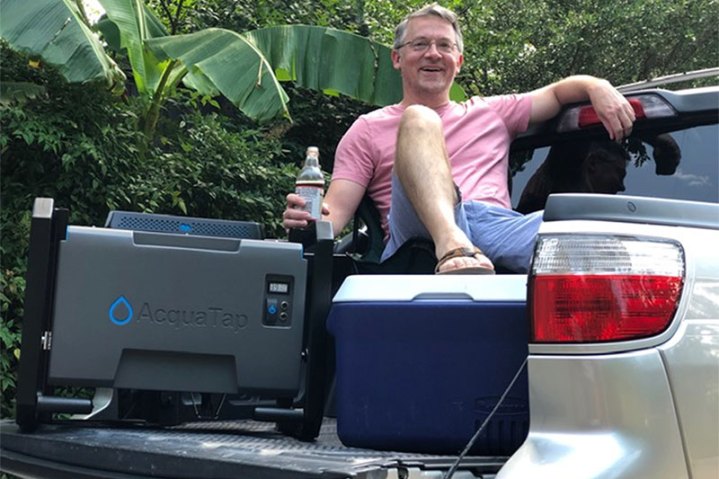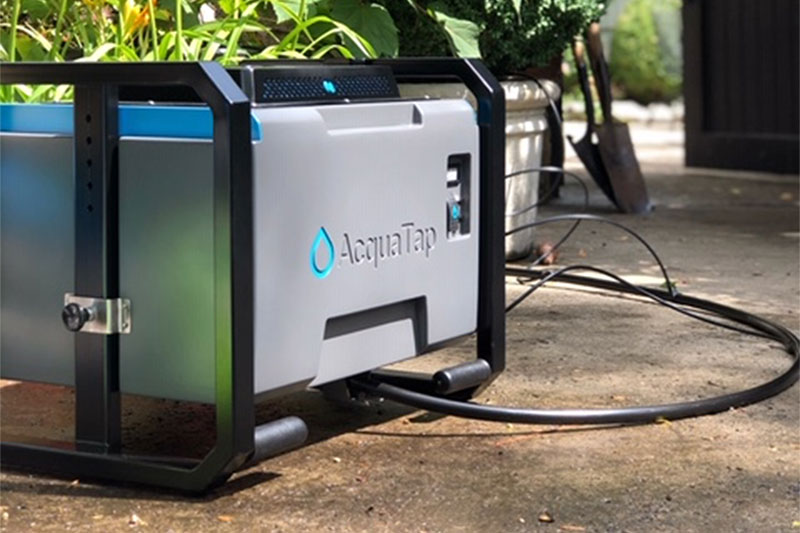
By 2030, the Earth’s population is expected to be around 9 billion, as humanity swells to flood every bit of dry land across the planet. The world will require 40% more fresh water than it has today, according to the 2030 Water Resources Group. And the amount of drinkable water that’s going to be created for all these thirsty bodies? Exactly zero … unless we can leverage the vast, unseen resources that exist all around us.
“There are, what, 37 quadrillion gallons of water in the air around us today? There’s an ocean of water up there that no one has really tapped into,” John Galbraith, the CEO of Exaeris Water Innovations, told Digital Trends exclusively. “The atmospheric water supply is just enormous,” agrees Mike Joyce, COO of the company.
Think about it: We constantly reference the humidity level, a number that spells out exactly how much of the air that we wade through is water. It’s not the heat, it’s the humidity that will kill you, the joke goes — but Exaeris thinks it’s the humidity that can save us.
It’s no secret that all the water vapor in the air can be extracted through the process of condensation. You see this any time you put a cool can of Coke down on a counter poolside, and watch the water bead up and run down the side of the can. Most techniques for extracting this water require a compressor, which passes refrigerated liquid across an evaporator coil, much like your fridge does. (Water is a waste byproduct in your fridge!) The only catch: Refrigerators are big, and they require a ton of power to operate. Doing it at any scale is impractical, to say the least. There’s a reason groups like The Thirst Project aim to address the world’s water needs by actively building hand-pump freshwater wells rather than simply passing out new fridges.
“An affordable device that’s available to millions of people around the world … that’s a game-changer. That’s a lifesaver,” Joyce said. So his company built one, spending years in stealth mode to identify, develop, and patent technologies that can extract water from the atmospheric water supply without relying on vapor compression.
At CES 2020, the company announced what it calls the AcquaTap technology; at CES 2021, Exaeris will unveil the first product using the tech, with plans to start taking orders at the Outdoor Retail Show in June and shipping it by the end of 2021. The portable device will weigh around 30 pounds and sell for less than $2,000, the pair told us. It will adapt to any power supply, from an outlet to solar power to battery, thanks to the miniaturized technology within, which will require very little power — equivalent to running a few incandescent lightbulbs all day long, Galbraith, co-inventor of the technology, tells Digital Trends.
While the company would not reveal the details of the patented technology, they did describe it as “hyperacceleration” of the condensation rate, allowing the device to produce 3.5 to 5 gallons of water a day, essentially for pennies per day. A companion app will allow owners to measure efficiency and output, and to program run time, if the AcquaTap performs better overnight, for example. The company will sell bladder bags for storage, irrigation devices, and other accessories to make the initial product work, and plans to scale the technology in the future for larger applications.
There are several target markets for such a product, including survivalists who routinely spend $2,000 or so per year on water already, in addition to the outdoor recreation space, where such a device has obvious applications. Beyond that, there’s the humanitarian potential of the AcquaTap, which could be a lifesaving part of the disaster relief kit brought in by organizations such as The Red Cross in the wake of hurricanes, tornadoes, and other disasters.
“There are parts of Puerto Rico that still don’t have functional infrastructure and water,” Joyce pointed out. There have been concerns in recent months about the global supply chain, which is making it hard to buy a new laptop and complicating your plans to buy a new VW or Audi. Joyce says his devices will be manufactured entirely in the U.S., to avoid these concerns.
“We want a good, reliable source, and we want that to be made in the U.S.,” he said.
We’ve written about ways to tap into the atmospheric water supply for years. In 2018, Digital Trends reported on an invention from MIT that pulls water from thin air, and a nanofiber cloth with similar capabilities, invented by researchers at Ohio’s University of Akron. But turning it into a product you can buy? Something about the size of a cooler that costs less than $2,000? That’s Tech for Change. That’s a lifesaver.
Editors' Recommendations
- The Box is an answer to the unstoppable cardboard pile-up in your house
- This clever attachment gives any powered wheelchair autonomous superpowers
- Razer’s high-tech face mask filters air and amplifies your voice, Bane-style
- LG TVs at CES 2021: OLED gets a brightness boost
- Samsung’s 2021 TV lineup surprises with Neo QLED, more MicroLED TVs






